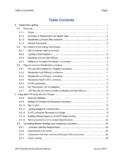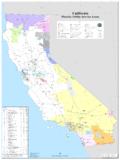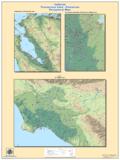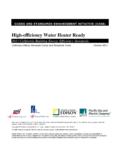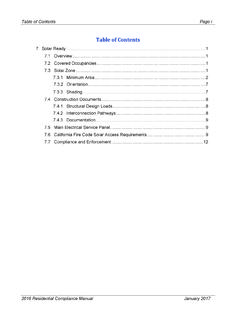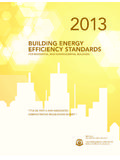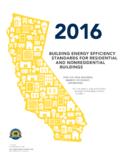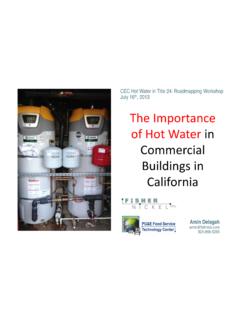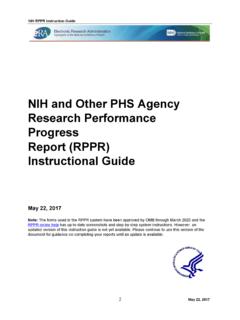Transcription of California Energy Commission Tracking Progress Zero ...
1 California Energy Commission Tracking Progress Last updated 7/5/2017 zero -Emission vehicle and Infrastructure 1 zero -Emission Vehicles and Infrastructure In his 2015 inaugural speech, Governor Edmund G. Brown Jr. put forward a goal to reduce today's petroleum use in cars and trucks by up to 50 percent by 2030. This was part o f his strategy to reduce greenhouse gas (GHG) emissions 40 percent below 1990 levels by 2030 as directed in Executive Order B-30-15. On September 8, 2016, Governor Brown signed Senate Bill 32 (Pavley, Chapter 249, Statutes of 2016), putting into law a statewide goal to reduce GHG emissions 40 percent below 1990 levels by 2030.
2 With transportation accounting for about 37 percent of California s GHG emissions in 2014,1 transforming California s transportation system away from gasoline to zero -emission vehicles is fundamental to the state s efforts to reduce GHG emissions . On March 23, 2012, Governor Brown issued Executive Order B-16-2012 to encourage ZEVs in California and set a long-term goal of reaching million ZEVs on California s roadways by 2025. The executive order established milestones for three periods: By 2015, California s major metropolitan areas will be able to accommodate ZEVsthrough infrastructure plans.
3 By 2020, California s ZEV infrastructure will be able to support up to 1 million vehicles. By 2025, million ZEVs will be on California s roadways with easy access Advancement zero -emission vehicles (ZEVs) plug-in electric vehicles (PEVs)2 and fuel cell electric vehicles (FCEVs) continue to need investments in front-loading the charging and refueling infrastructure to support new vehicle rollouts, technological advancements in battery capacity and vehicle range, increased power capacities of fast chargers, and advancements in producing and dispensing hydrogen fuel.
4 In addition to Executive Order B-16-2012, the following provide guidance to the Energy Commission and collaborative statewide efforts in t he advancement of ZEVs and supporting infrastructure: Governor s 2016 ZEV Action Plan3 Released to the public in mid-October 2016, the updated 2016 ZEV Action Plan outlinesprogress to date and identifies new actions state agencies will take in continued pursuitof the milestones in the Governor s executive 2016 ZEV Action Plan highlights the following priorities for ZEVs:1 California Air Resources Board, GHG Emission Inventory 2016 Edition, 2 Includes battery electric vehicles (BEVs) and plug-in hybrid electric (PHEVs).
5 3 California Energy Commission Tracking Progress Last updated 7/5/2017 zero -Emission vehicle and Infrastructure 2 oRaising consumer awareness and education about ZEVsoEnsuring ZEVs are accessible to a broad range of CaliforniansoMaking ZEV technologies commercially viable in targeted applications the medium-duty, heavy-duty, and freight sectorsoAiding ZEV market growth beyond CaliforniaThe 2016 ZEV Action Plan introduces new actions to meet these priorities and build California s ZEV market, remove barriers to future market growth, and ensure this transition benefits the state and its residents.
6 The intent is to clearly communicate what state government will do to advance ZEVs and serve as a to-do list for the Governor s Office and state agencies to enhance interagency coordination. The Energy Commission has been tasked in various lead and supporting roles within the 2016 ZEV Action Plan. For public Tracking , staff is developing an informational dashboard Web page for the Energy Commission s activities on the action plan. California Sustainable Freight Action Plan4 Governor Brown s Executive Order B-32-15 directed the Secretary of California StateTransportation Agency (CALSTA), Secretary of the California Environmental ProtectionAgency (CalEPA)
7 , and the Secretary of the Natural Resources Agency to lead otherrelevant state departments in developing an integrated action plan by July 2016 that establishes clear targets to improve freight efficiency, transition to zero -emissiontechnologies, and increase competitiveness of California s freight system. Theparticipating state departments are the California Air Resources Board (CARB), California Department of Transportation (Caltrans), Energy Commission , and theGovernor s Office of Business and Economic Development (GO-Biz).
8 This action plan will serve to coordinate state agency priorities and timing on actions toinfluence freight transportation and Energy infrastructure, vehicle and equipmenttechnologies, and facility and operations efficiency, rather than the traditional andseparate planning efforts for transportation, environment, and Energy . The action planincludes recommendations on:oA long-term 2050 vision and guiding principles for California s future freighttransport for 2030 to guide the state toward meeting the to leverage state freight transport system to initiate over the next five years to advance toward the targets and California Energy Commission Tracking Progress Last updated 7/5/2017 zero -Emission vehicle and Infrastructure 3 oPilot projects to achieve on-the-ground Progress in the near concepts for further exploration and development, if viable.
9 Senate Bill 350 (De Le n, Chapter 547, Statutes of 2015) Clean Energy and PollutionReduction ActSB 350 increases California s renewable electricity procurement goal from 33 percent by2020 to 50 percent by 2030. Further, SB 350 requires a doubling of statewide energyefficiency savings in electricity and natural gas end uses by 2030. To help ensure thesegoals are met and the GHG emission reductions are realized, specified load-servingentities are required to develop integrated resource plans (IRPs). These IRPs will detailhow each entity will meet their customers resource needs, reduce GHG emissions , andramp up the deployment of clean Energy 350 requires California s publicly owned utilities (POUs) with annual electricitydemand exceeding 700 gigawatt-hours to develop and adopt IRPs by January 1, IRPs must discuss how each POU plans to meet GHG reduction targets establishedby the ARB and identify procurement plans of at least 50 percent renewable energyresources by 2030.
10 SB 350 requires that the POU IRPs also address their procurementplans for electrification of the transportation sector within their service territory. The IRPsmust be submitted to the Energy Commission to review for consistency with thelegislative requirements. To expedite review of the IRPs, SB 350 authorizes the EnergyCommission to adopt guidelines that will provide a framework for the information anddata to be submitted by POUs. Volkswagen Settlement California ZEV Investments5 Appendix C of the consent decree (the ZEV Investment Commitment) requires VW toinvest $800 million in ZEV projects in California over a 10-year period.
